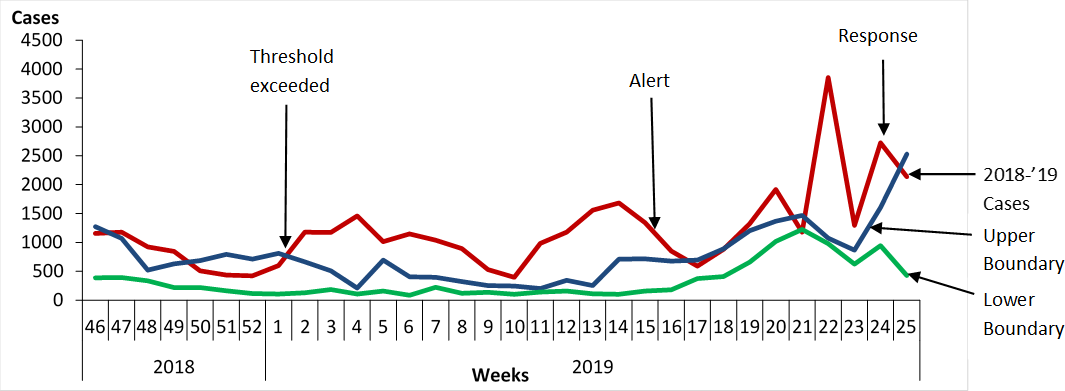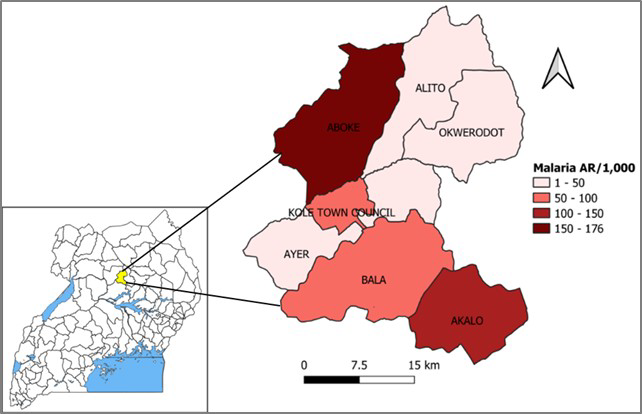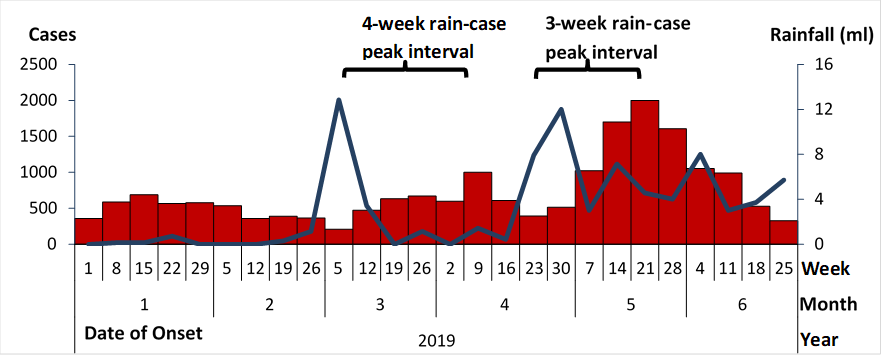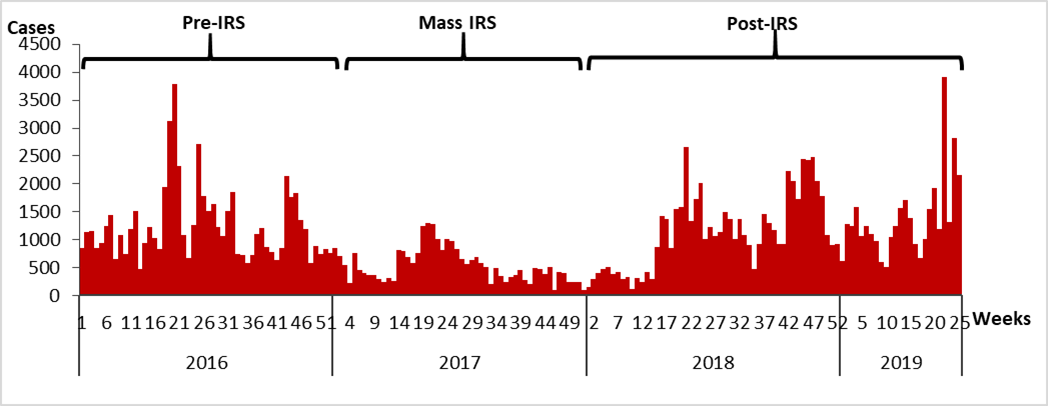Malaria Outbreak Facilitated by Increased Mosquito Breeding Sites Near Homes and Cessation of Indoor Residual Spraying, Kole District, January-June 2019
Authors: Maureen Nabatanzi1, Vivian Ntono1, John Kamulegeya1, Benon Kwesiga1, Bernard Lubwama2, Alex Riolexus Ario1 | Affiliations: 1Uganda Public Health Fellowship Program, Ministry of Health, Kampala, Uganda 2Integrated Epidemiology, Surveillance and Public Health Emergencies Department, Ministry of Health, Kampala, Uganda
Summary
In June 2019, analysis of surveillance data showed that malaria cases in Kole District had exceeded the action thresholds since January 2019. We investigated to identify exposures and recommend interventions. We defined a confirmed case as a positive test by Malaria Rapid Diagnostic Test or microscopy in a resident of Kole District from 1 January-30 June 2019. We conducted active case search and assessed exposures in a 1:1 matched case-control study (n=282). We also conducted entomological and environmental assessments. Of 18,737 confirmed case-persons, residents of Aboke sub-county
(AR=176/1,000) and children <5 years (AR=94/1,000) were most affected. Trends showed a sharp decline in malaria incidence from 2016-2017, after the district had an indoor residual spraying (IRS) campaign. Two malaria upsurges occurred 3-4 weeks after increases in rainfall. Twenty two (16%) case-persons and 4 (2.9%) controls had stagnant water in abandoned containers near their houses (ORMH=7.0, 95% CI=2.1-24); 27 (19%) case-persons and 11 (7.8%) controls had stagnant water near their houses (ORMH=3.0, 95% CI=1.4-6.7). One hundred and four (73%) case-persons and 89 (63%) controls farmed <500m from swamps (ORMH=2.3, 95% CI=1.1-4.4). Adult Anopheles mosquitoes, larvae, pupae, and shells were identified near affected houses; per 500ml scoop, 10 larvae and 4 pupae and shells were estimated. Over half (59%) of houses had a damaged bed net. We concluded that stagnant water near houses and farming in swamps likely facilitated this outbreak through increases in mosquito breeding sites following rains. Ecological assessment linked IRS to declines in malaria, and its cessation to increases. We recommended sensitizing communities about removal of mosquito breeding sites, re-introduction of IRS campaigns, and mass distribution of bed nets in Kole District.
Introduction
The transmission intensity of malaria largely depends on the vector density which is favored by the presence of breeding sites like small pools of water (1). In 2016, Kole District in Lango sub-region of Northern Uganda reported an incidence of 121 malaria cases per 1,000 population compared to the sub region incidence of 109 per 1,000 (2). In response, Ministry of Health (MoH) conducted in door residual spraying (IRS) in 11 districts in Eastern and mid-Northern Uganda including Kole in 2017 (2).
In June 2019, routine analysis of surveillance data showed that malaria cases exceeded the action thresholds from January 2019 (Figure 1). We investigated to determine the scope of the upsurge, identify exposures for transmission, and recommend evidence based interventions.,

Figure 1: Normal channel showing increase in weekly malaria cases in Kole District, 2019
Methods
We defined a confirmed case as a positive malaria Rapid Diagnostic Test (RDT) or microscopy in a resident or visitor of Kole from 1 January 2019 to 30 June 2019. We systematically searched for malaria cases by reviewing outpatient health records. We described case- persons by person, place and time. We interviewed 20 case persons in the most affected parish, Ogwangacuma on exposures to malaria. Exposures were assessed in a 1:1 matched case-control study (n=282) in Aboke sub-county. In the 2 most affected parishes Ogwangacuma and Akwirididi, we selected 10 villages and applied probability proportionate to size to determine number of cases per village. Selection of cases and their controls followed systematic sampling using a list of all households per village as the sampling frame and matched by village and age. We conducted entomological and environmental assessments to identify risk factors for mosquito breeding. We extracted confirmed malaria cases for the period 2016- 2019 from the District Health Information System (DHIS2) to de- scribe trends in relation to IRS.
Results
We line listed 18,737 confirmed case-persons of which 12,535 (67%) Anopheles gambiae and Anopheles funestus adult mosquitoes were identified at breeding sites near houses. Per 500ml scoop, were females with an attack rate (AR) of 90 per 1,000 compared to the 6202 (33%) males, AR = 46/1,000. The median age was 12 years (Range = 0-98). Children less than 5 years were most affected (AR = 94/1,000) compared to children aged 5 to 18 years (71/1,000) and adults (56/1,000). Residents of Aboke sub-county were the most affected (AR= 176/1000) followed by Akalo (AR = 106/1000) (Figure 2). Symptoms of case persons included: fever (98%), vomiting (42%) and headache (32%) among others.

Among the parishes of Aboke sub-county, residents of Ogwangacuma were the most affected (AR = 345/1,000), followed by Opeta (AR = 325/1,000). The epidemic curve showed a general increase in malaria cases in 2019 with upsurges on 9 April and 21 May that occurred 3-4 weeks after increases in rainfall (Figure 3).

Figure 3: Confirmed malaria cases and average rainfall in Kole District, January to June 2019Trends showed a sharp decline in malaria incidence from 2016- 2017, after the district had an indoor residual spraying (IRS) campaign. However, cases increased steadily from mid-2018 through the 2019 outbreak.

Figure 4: Confirmed malaria cases and timing of mass IRS in Kole District, 2016-2019In Aboke sub-county, we identified rice farms in swampy areas. Swamps had stagnant water in which mosquitoes were breeding Anopheles gambiae and Anopheles funestus adult mosquitoes were identified at breeding sites near houses. Per 500ml scoop, larvae (10), pupae and shells (4) were estimated. Hypothesis generation interviews found that: 17 (85%) case-persons lived in houses within 500m of swamps, 15 (75%) reported human activities like rice farming within 500m of swamps, 11 (55%) had stagnant water near their houses either standing alone or in abandoned contain Case-control findings
Among 141 case-persons and 141 controls, 22 (16%) case-persons and four (2.9%) controls had stagnant water in abandoned containers near their houses (ORMH=7.0, 95% CI=2.1-24); 27 (19%) case-persons and 11 (7.8%) controls had stagnant water near their houses (ORMH=3.0, 95% CI=1.4-6.7); and 104(73%) case-persons and 89 (63%) controls farmed <500m from swamps (ORMH=2.3, 95% CI=1.1-4.4). Net use was 80% (113) among case-persons and 81% (114) among controls (ORMH=0.9, 95% CI=0.5-1.8) but 59% of all participants had at least one damaged net in their household.
Discussion
Trends showed a sharp decline in malaria incidence from 2016- 2017, after an indoor residual spraying (IRS) campaign. In 2019, two malaria upsurges followed increases in rainfall. The outbreak was associated with stagnant water in abandoned containers or standing near houses, and farming near swamps.
In malaria endemic populations, vector densities fluctuate with seasonal changes in climatology. Similar to our findings, a positive correlation between rainfall and malaria was reported in Gulu District. This seasonal trend in malaria was only interrupted by the introduction of IRS (3). The IRS campaign conducted in Kole in 2017 could explain the lower reported cases that year. Stagnant water and flooding near houses favor vector breeding and increase the risk of malaria infection; this explains the positive association reported in our findings (4). Human activities like rice farming in swamps also led to creation of stagnant water turning the swamps into vector breeding sites.
In 2017, MoH conducted a routine bed net distribution that achieved 88% national coverage (2). In our study over half of net owners had at least one damaged bed net. This could explain why net use was not significantly protective. It is also argued that in areas with vector breeding favorable rainfall conditions like those in Kole, the use of bed nets alone in the absence of other malaria interventions like IRS is ineffective (3).
In 2017 to early 2018, the cases declined and this coincided with a mass IRS with Actellic 30S insecticide conducted in 11 mid-northern Uganda districts including Kole (2). Similarly, a study in Gulu District reported two major consecutive malaria epidemics nine months after discontinuation of IRS (3). These findings highlight the need to sustain IRS to reduce malaria cases.
Conclusions and recommendations:
Stagnant water near houses and farming in swamps likely facilitated this outbreak through increases in mosquito breeding sites following rains and poor personal protection. Ecological assessment linked IRS to malaria declines, and its cessation to increases. We recommended sensitizing communities about removal of mosquito breeding sites, re-introduction of IRS, and mass distribution of bed nets in Kole District.
References
1. UBOS. Uganda Malaria Indicator Survey 2009. Kampala, Uganda: Uganda Bureau of Statistics and ICF Macro 2010.
2. MoH. National Malaria Annual Report 2017-2018. Kampala, Uganda: National Malaria Control Division, Surveillance Monitoring & Evaluation Unit, Division NMC; 2019.
3. Simple O, Mindra A, Obai G, Ovuga E, Odongo-Aginya EI. Influence of Climatic Factors on Malaria Epidemic in Gulu District, Northern Uganda: A 10-Year Retrospective Study. Malaria Research and Treatment. 2018;2018:8.
4. Hajison PL, Feresu SA, Mwakikunga BW. Malaria in children under-five: A comparison of risk factors in lakeshore and highland areas, Zomba district, Malawi. PLOS ONE. 2018;13(11):e0207207.

